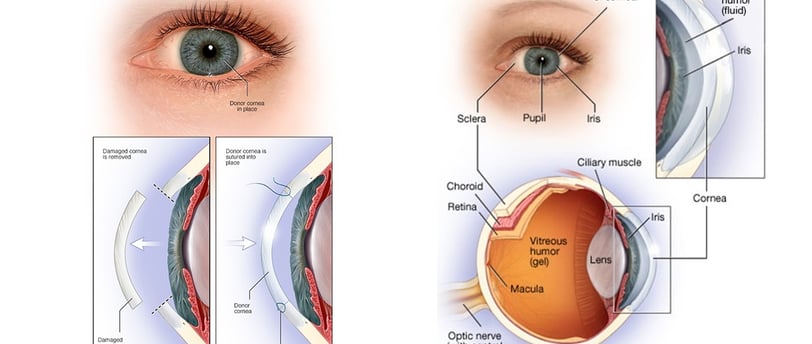Corneal Transplantation: Restoring Vision Through Advanced Surgery
3 min read


The cornea, the transparent front layer of the eye, plays a crucial role in our vision. It not only allows light to enter the eye but also helps focus it onto the retina, enabling us to see both near and far objects clearly. When the cornea becomes damaged or diseased, a corneal transplant may be necessary to restore vision. In this blog post, we'll explore the cornea's function and the revolutionary procedure of corneal transplantation.
Understanding the Cornea
The cornea is the clear, dome-shaped surface that covers the front of the eye. It sits just in front of the iris, the colored part of the eye. While the iris determines eye color, the cornea itself is completely transparent. The cornea serves two primary functions:
It acts as a protective barrier for the eye.
It refracts (bends) light entering the eye, helping to focus it on the retina for clear vision.
What is Corneal Transplantation?
Corneal transplantation, also known as keratoplasty, is a surgical procedure where a damaged or diseased cornea is replaced with healthy corneal tissue from a donor. This donor tissue comes from someone who has passed away and chosen to donate their corneas, much like other organ donations.
When is Corneal Transplantation Necessary?
Corneal transplants may be recommended for various conditions, including:
Keratoconus (a cone-shaped bulging of the cornea)
Fuchs' dystrophy
Corneal scarring from injury or infection
Corneal ulcers
Complications from previous eye surgeries
Types of Corneal Transplants
There are several types of corneal transplant procedures, including:
Penetrating Keratoplasty (PK): The full thickness of the cornea is replaced.
Deep Anterior Lamellar Keratoplasty (DALK): The front and middle layers of the cornea are replaced, leaving the inner layer intact.
Endothelial Keratoplasty: Only the innermost layer of the cornea is replaced. This includes:
Descemet's Stripping Endothelial Keratoplasty (DSEK)
Descemet's Membrane Endothelial Keratoplasty (DMEK)
The choice of procedure depends on which layers of the cornea are affected by disease or damage.
The Corneal Transplant Procedure
Corneal transplant surgery is typically performed by an ophthalmologist specializing in corneal diseases. The procedure is usually done under general anesthesia, although in some cases, local anesthesia with sedation may be used.
The surgeon measures the patient's eye to determine the size of cornea needed.
The damaged cornea is carefully removed.
The donor cornea is precisely cut to fit and then sewn into place with ultra-fine sutures.
In some types of transplants, an air bubble may be used to position the new corneal tissue instead of sutures.
The entire procedure usually takes one to two hours.
Recovery and Aftercare
Recovery from a corneal transplant takes time. While you may be able to return home the same day as your surgery, it can take several months for your vision to stabilize. During this time:
You'll need to use eye drops to help prevent rejection and infection.
You'll have several follow-up appointments to monitor your progress.
You may need to wear an eye patch or shield to protect your eye.
You should avoid rubbing your eye and strenuous activities.
Success Rates and Risks
Corneal transplants have a high success rate, with over 90% of transplants still functioning after one year. However, as with any surgery, there are risks, including:
Rejection of the donor cornea
Infection
Glaucoma
Astigmatism
Conclusion
Corneal transplantation is a remarkable procedure that has restored sight to countless individuals suffering from corneal diseases or injuries. As surgical techniques and post-operative care continue to advance, the outcomes for patients needing this sight-saving surgery continue to improve.
If you're experiencing vision problems or have been diagnosed with a corneal condition, consult with an ophthalmologist to discuss whether corneal transplantation might be right for you. Remember, early detection and treatment of eye conditions can often prevent the need for more invasive procedures down the line.